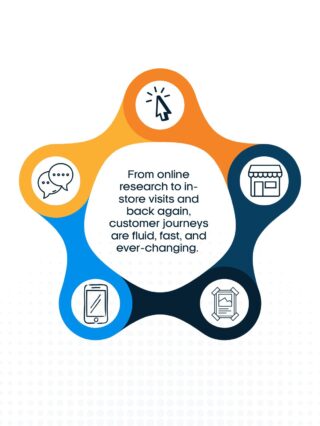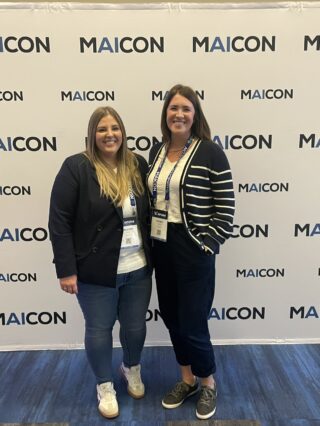We had the opportunity to attend this year’s Gartner IT Symposium/Xpo™ and left feeling inspired to live and work through the theme of: Meet the Moment. Make the Difference. As a purpose-fueled organization, we felt compelled to join the movement as we have always lived by our own guiding mantra of: Create Connections. Make a Difference.
The theme serves as a powerful and timely call to action–addressing significant challenges faced by CIOs and IT Executives alike. The forces of innovation, disruption, and market evolution are more prevalent than ever before. To navigate these new and arising challenges in an evolving and technologically advanced industry, we’ve highlighted key takeaways from our experience at The Gartner IT Symposium/Xpo™.
Be Clear About the Digital Ambition of the Organization
The term ‘Digital Transformation’ can be compared to ‘Analytics,’ in that it is thrown around often as a loose term. Digital Transformation means different things to different organizations and stakeholders. It’s frequently overused and misinterpreted. While it’s fair to say that most organizations have a Digital Transformation Strategy, not everything is considered Digital Transformation. To delineate Digital Transformation from other strategies such as Tech Enablement and Business Optimization, Gartner defines Digital Ambition into three categories:
- Tech Enablement: focused on improving current work (often manual) with technology.
- Business Optimization: focused on improving business processes and workflows.
- Digital Transformation: the creation of new products, services, capabilities, and business models.
Tech Enablement and Business Optimization improve current state. They are both iterative and evolutionary, while Digital transformation is about creating new value.
Change Management Is the Ultimate Competitive Edge
Technology has infiltrated every aspect of life and the rate of change and innovation will only continue to accelerate. The rate of change can be broken down into two scenarios:
The Change We Initiate: New business models, reorganization, new technology, and new ways of working. The change we iterate builds a culture of agility and change management that has a direct impact on innovation, customer experience, employee engagement, and growth. It starts and ends with focusing on ‘the why’ of when, how, what, and/or for whom we provide products or services for.
Why do we need to change, and does it make a difference for the organization, employees, and customers? The ‘why’ needs to be thoughtful, strategic, and most of all, personal. Change management is a must-have strategy and the successful implementation of any change ultimately comes down to people and if they believe in the process and buy in to the idea or strategy.
The Change We React To: New market conditions, a pandemic, geo-political climate, inflation, supply-chain challenges, and new regulations. The goal is to build and maintain resiliency. The ability to navigate and overcome obstacles and challenges across people, process, technology, and partners will be telling of the success and fortitude of an organization. We like to think that we are constantly ‘building comfort in ambiguity,’ by incorporating scenario planning and investing in critical redundancy and disaster recovery in order to fortify and future-poof our business.
An example of future planning is being prepared for a weather-related problem like losing power for an extended period of time or snow preventing employees from driving into the office. By investing heavily in technology-enabled mobile and virtual workforce initiatives, employees experience minimal disruption from location, weather, or any other factors. When the pandemic hit and the world was forced to work from home, our employees could experience a smooth transition with work as the world around them became more chaotic and unknown. This positioned our employee-owners to navigate sudden change and we have found more success than ever because of this preparation.
Cybersecurity and Data Management Is a Business Challenge
There are new cyber threats every day and they are increasingly getting more intelligent. Most experts say that the likelihood of a cyber incident is not a matter of if, but when. Every employee has a part to play in what is now very much a team sport. As leaders assess and mature cybersecurity capabilities, the ultimate business objective or ROI comes down to one thing: consumers need to be able to trust your brand.
Treating cybersecurity and data management as a business imperative vs. a corporate training exercise is paramount to staying ahead of the curve and ahead of cyber threats that could dismantle key aspects of your organization–effectively putting your business and your employees at risk. Organizations need to understand and validate their supply-chain and strategic partners for compliance, proper controls, and business continuity. Engage with employees, partners, and customers to bring stakeholders into this mindset of cybersecurity and data as a business need and a commonplace practice.
Stepping Back
‘We live and work in uncertain or unprecedented times,’ is perhaps the biggest and most overused understatement of our generation. The difference between viewing the future with a sense of optimism and excitement vs. fear and feeling overwhelmed comes down to a positive and receptive culture. As we reflect on the conference theme of Meet the Moment. Make a Difference., we have a greater appreciation and comprehension of the impact of technology, leading through uncertainty, fortifying for the future, and embracing change management.
“A culture of people sharing a vision and working together toward a common goal and purpose will always lead to successfully creating connections and making a difference.”– Mike Della Porta, COO & CIO





